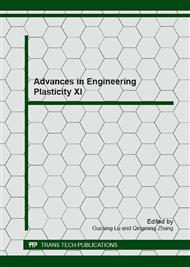p.369
p.373
p.377
p.381
p.385
p.389
p.393
p.397
p.401
Elasto-Plastic Property of High Strength Steel at Warm Temperature and its Springback
Abstract:
Stress-strain responses of a high strength steel sheet of 980MPa grade under uniaxial tension and its springback in V- and U-bending were investigated at elevated temperatures ranging from 573-973K. The flow stress decreased drastically with the increase of temperature, from which it was expected that springback is reduced by warm forming. In V-bending test, however, the temperature effect on springback was not so clear, while in U-bending springback decreased with temperature rise. It was found that such difference in temperature dependent springback behavior between V- and U-bending was caused by stress relaxation which took place during unloading process.
Info:
Periodical:
Pages:
385-388
Citation:
Online since:
January 2013
Keywords:
Price:
Сopyright:
© 2013 Trans Tech Publications Ltd. All Rights Reserved
Share:
Citation:


